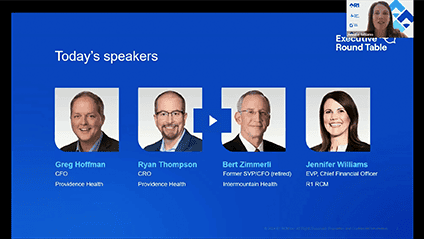If you’re like most healthcare executives, you’ve probably spent countless hours thinking about a host of challenges including rising operating costs, the labor market and how to improve the patient experience. You’ve probably read articles about RCM outsourcing, watched webinars and analyzed data about the impact it can have. Maybe you’ve even spoken to health systems who have taken on an enterprise RCM outsourcing solution.
If you fit into the above category, you’re not alone. A data-backed survey of CFOs and revenue cycle leaders recently confirmed the industry’s strong focus on finding strategic partnerships. In fact, the survey data showed 28% of respondents – the top response – said their top revenue cycle solution was to find a strategic revenue cycle management outsourcing partner.
This type of decision not only requires careful thought, but it also requires insight from someone who’s been there before. Since we can’t be in the room as executives make RCM outsourcing decisions, we sat down with Todd Craghead, former vice president of revenue cycle at Intermountain Healthcare (IMH), to discuss his perspective on outsourcing. He provided candid information about what led IMH down the path to RCM outsourcing, including managing multiple partners, financial metrics they were trying to improve and how key stakeholders are impacted.
The journey to RCM efficiency
For years, revenue cycle management partnerships and vendors have been an important part of how health systems have operated. However, due to the current state of hospital finances, health care executives are now recognizing the urgent need to make more digital and cultural transformations to push towards greater RCM efficiency. This greater push has created new forms of partnership that have been adopted by large health systems such as Ascension, Sutter Health and Intermountain Healthcare.
According to Craghead, IMH started their RCM efficiency journey more than 15 years ago as the organization observed many decentralized revenue cycle teams trying to operate across the system. “By nature of that, it’s obvious they weren’t obtaining the efficiency, nor the benefits they could by being together and aligned,” said Craghead. This led to a multi-year journey of organizing and centralizing the teams – both physically and in terms of process management. Over time it evolved to include leveraging third-party technology, and utilizing outside organizations to provide RCM insight, guidance and leadership.
Read more.
Want more information about how to choose a revenue cycle partner? Download the research brief, Vetting the Right Revenue Cycle Partner, published by The Health Management Academy.
The struggles of managing several RCM partners
Revenue cycle partnerships are not a new concept. In fact, recent research from The Health Management Academy and R1 RCM recently found that over 90% of health care organizations are relying on at least one strategic revenue cycle partner. Many organizations use multiple partners to address specific elements of their revenue cycle, such as eligibility, denials or patient collections. The process of managing multiple partners is challenging for health systems. It requires more time and greater coordination and management, and many health systems say the process has left them with siloed technology systems that don’t integrate with each other.
Craghead says another problem with managing multiple RCM partners is that it may also create a “fragmented patient experience based on who the patient is interacting with.”
Due to all these issues, he said IMH began looking for a long-term structured relationship based on strategy and long-term goals, in which they didn’t have to manage several partners.
“What motivated Intermountain was this continued pressure that suggested we could work better, more efficiently and at a lower cost,” said Craghead.
Growing financial pressure
There’s probably no health system that isn’t trying to improve its key financial AR metrics, and IMH was no exception. According to Craghead, the growing pressures on these metrics was also a motivating factor that led the health system down the path to an enterprise outsourcing partnership.
“When you watch those metrics start to apply pressure, which influences the day’s cash on hand for many organizations and the way that they are operating, it motivates a new way of thinking,” said Craghead. He points to examples such as uncompensated care, the number of payer days that continue to grow and the strain around how the payers are adjudicating the claims, as three examples of continuing financial pressures and razor thin operating margins.
Craghead points out that when you review all the pressures, you’re left with an opportunity around how to make changes that reduce friction from the process, which can ultimately increase revenue cycle management efficiency and increase the yield on the dollars due to the system.
New data-packed report now available.
If you’re looking for key trends, data insights and clear-cut opportunities for cutting costs, increasing revenue and improving the patient experience, download our exclusive report now.
The impact to key stakeholders
Craghead says the impact of outsourcing on key stakeholders cannot be overlooked. Entering into an RCM outsourcing partnership means many changes for all parties – patients, employees, health systems and providers. The transitions these groups will go through can be greatly eased by planning, advanced preparation and choosing the right partner.
Patients
The revenue cycle is one of the only parts of healthcare that follows the patient from beginning to end – from scheduling and check-in, all the way through final payment. These stakeholders should be at the center of any revenue cycle partnership discussion.
One specific area to consider from the patient’s perspective is how the use of patient-facing technology can benefit the patient financial experience. Most patients are already comfortable using technology across all areas of their life – from online shopping to online bill pay – this has become common place. Craghead says with the rapid pace of technology acceleration, there are ways to continue leveraging this technology into the healthcare setting.
According to Craghead, strategic revenue cycle partners can help integrate the use of patient-facing technology to ensure it is positively woven into the patient experience and into their existing electronic medical record platform. Having an RCM partner with this expertise – and a solid plan – ensures seamless integration.
Employees
In many cases a full enterprise revenue cycle partnership involves an employment transition for the revenue cycle employees, as was the case for Intermountain Health. “This is a hard part,” said Craghead. “Many of these folks have invested their careers, their time and their talent to the health system.”
He stressed that each organization who goes through this should be very thoughtful about how they structure their agreements, in part because the agreements can help ensure the employees are well cared for both during and after the employment transition. He also says this practice can create a level of trust and transparency between the health system and RCM partner, ensuring long-term success.
Craghead said employees can experience many benefits as a result of the transition, and those should be communicated. The first is one of career and growth opportunities. Due to the size of many health systems, there can be limited growth opportunity for health system revenue cycle employees. However, a large organization that focuses solely on revenue cycle management has more opportunity for career growth. Employees may also learn there is a stronger and wider network of employees they can tap into when needed, which can improve their day-to-day workload. A second benefit is that with a strategic, tech-forward RCM partner, employees will have improved access to tools, software and automation resources that can allow them to do their job better, faster and more efficiently.
Health systems and providers
While the overall health system is the entity to make this decision, they and the providers are also stakeholders.
As a whole, health systems are trying to identify ways to be more efficient and to produce an outcome that can help them fulfill their mission of delivering the best patient care at the lowest price to the communities they serve. Likewise, providers are doing the same thing. They want to focus on patient care and eliminate some of the administrative burden related to current system processes.
How can health systems and providers best do this? Craghead says working with an enterprise RCM partner can help leverage the scaled people, process and technology needed so that health systems and providers can focus exclusively on caring for their patients. When health systems are looking for an RCM partner, Craghead suggests looking for a partner who has the capacity to grow and develop technology in an accelerated way. He says this helps the health system make meaningful changes in a short amount of time.
Getting to RCM efficiency
The road to RCM efficiency can take many routes. One health system may jump in with both feet, while another may take small steps over the course of many years. While there is no ‘one size fits all’ approach, the important part is that health systems keep moving forward to optimize and invest in their people, processes and technology and embrace an open mind regarding outsourcing partnerships that can provide an innovative way forward.
Regarding making the big decisions and changes necessary to becoming fully efficient in your revenue cycle, Craghead said, “It takes courage, and it takes leadership. You have to have a goal in mind around what you’re trying to accomplish and how you’re trying to accomplish it.”
Takeaways:
- For years, RCM partnerships and vendors have been an important part of how health systems have operated. However, a new level of strategic RCM enterprise partnership is on the rise due to the financial challenges hospitals and health systems continue to experience.
- Many organizations use multiple partners to address specific elements of their revenue cycle. This can lead to a disjointed patient experience and duplicative work, not to mention added stress from managing multiple partner relationships.
- Many financial metrics can be improved through RCM outsourcing. The increased efficiency reduces friction from the process, which can increase the yield on the dollars due to the health system.
- Choose an RCM partner with ample experience leveraging patient-facing technology into the healthcare setting to benefit the patient financial experience.
- In many cases revenue cycle partnerships involve an employment transition. Health systems should be very thoughtful about how they structure their agreements, as this can ensure the employees are well cared for both during and after the employment transition. In many cases there can be numerous opportunities for career growth and those should be communicated.
- RCM partnerships can help health systems fulfill their mission of delivering the best patient care at the lowest price to the communities they serve. These partnerships can also allow providers to spend more time on patient care and eliminate some of the time-consuming administrative burdens they face.
Watch Now.
Want to know what it’s like to become an R1 employee? Hear from some R1 associates who made the switch.
Author Bio: Content written on behalf of R1 RCM.





